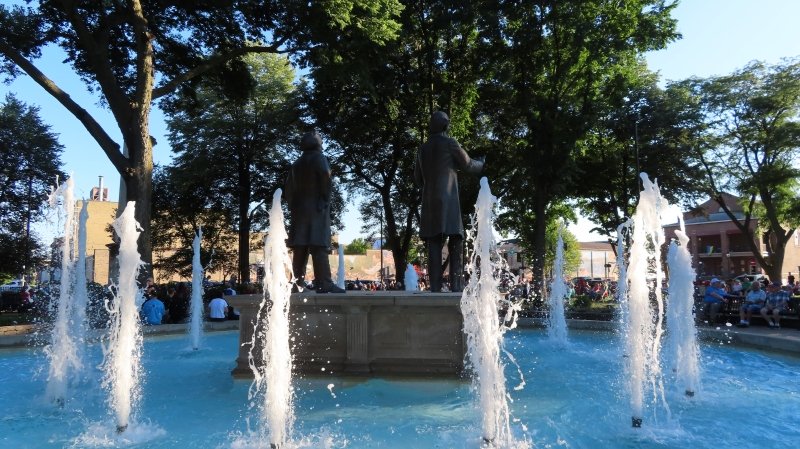The Roxy Theatre in Ottawa, Illinois, has a rich history that mirrors the evolution of American entertainment and remains a cultural cornerstone for the community. Here’s its story, from its vaudeville origins to the present, along with its significance to Ottawa.
Origins and Vaudeville Days (1910–1932)
The Roxy began as the Gayety Theatre, opening around 1910 as a vaudeville house in downtown Ottawa at 827 La Salle Street. Vaudeville was a vibrant form of live entertainment, featuring a variety of acts like singers, dancers, comedians, and acrobats. The Gayety was a grand venue for its time, boasting a full wooden stage with flies above for scenery, dressing rooms below, and a lighting panel with copper knife switches. It reportedly had a balcony, suggesting a sizable capacity, and was considered one of Illinois’ finest vaudeville theaters. The theater’s interior was adorned with six large paintings by Isabelle Sanders, a local Ottawa Township High School teacher and artist, depicting scenes like Starved Rock, adding a touch of local pride and artistic flair.
During the silent film era, the Gayety adapted to changing tastes, with live organ accompaniment for movies—a role filled by at least one resident who later helped redecorate the theater. The venue hosted a mix of live performances and early films, serving as a social hub where Ottawa residents gathered for entertainment. Its stage and facilities supported a range of productions, from traveling vaudeville troupes to community events.
Transition to Cinema and Renaming (1932–1980s)
In 1932, the Gayety was renamed the Roxy Theatre, likely inspired by the famed Roxy Theatre in New York City, a nod to the era’s glamorous movie palaces. This marked its full transition into a movie theater, reflecting the decline of vaudeville and the rise of cinema. The Roxy became part of the Alliance Theater chain and introduced innovations like push-back rocking seats, a novelty at the time. It embraced new film technologies, screening 3D films like Bwana Devil and CinemaScope epics like The Robe in the 1950s.
The theater’s programming in the 1940s and 1950s was structured: shows ran Sunday to Tuesday, a double feature with “dish night” (where patrons received free dishes) on Wednesdays, and another program Thursday to Saturday. The box office stood on the sidewalk under a marquee, with an upright sign adding to its prominence. If the projectionist missed a cue, audiences would stomp and clap, a testament to the lively, communal atmosphere. The Roxy’s role as a cultural anchor grew as it provided affordable entertainment during the Great Depression and World War II, offering escape and connection for Ottawa’s residents.
Modernization and Expansion (1980s–2000s)
In the mid-1980s, the Roxy underwent significant remodeling, splitting its single auditorium into a twin-screen theater to compete with modern multiplexes. A few years later, four additional screens were added, bringing the total to six and increasing capacity to 750 seats. This expansion preserved the theater’s viability as smaller, single-screen venues struggled. The Roxy joined the VIP Cinemas chain, which continues to operate it today, focusing on a premium movie-going experience with comfortable seating and state-of-the-art facilities.
Despite these changes, traces of its vaudeville past remained. Former employees recall the original stage behind the screen and the historic dressing rooms, though the balcony was likely removed during renovations. The theater’s inclusion in the Ottawa Commercial Historic District, listed on the National Register of Historic Places, underscores its architectural and historical value.
The Roxy Today (2025)
Today, the VIP Roxy Cinemas remains a thriving six-screen theater, showing the latest blockbusters and offering amenities like annual popcorn buckets and clean, accessible facilities. Reviews praise its friendly staff, comfortable seating, and affordable prices, making it a standout in a 50-mile radius. While it no longer hosts live performances, its role as a cinema keeps it central to Ottawa’s cultural life. The theater’s website (roxycinemas.com) and ticketing platforms like Fandango and Atom Tickets make it easy for patrons to plan visits.
Importance to Ottawa, Illinois
The Roxy is more than a movie theater; it’s a cultural and historical touchstone for Ottawa, a city of about 18,000 people. Its significance lies in several key areas:
- Historical Continuity: Operating for over a century, the Roxy has survived economic hardships, wars, and shifts in entertainment trends. Its vaudeville roots and adaptation to cinema reflect Ottawa’s resilience and ability to evolve while honoring its past.
- Community Hub: From vaudeville crowds to modern moviegoers, the Roxy has been a gathering place where generations of Ottawa residents have shared experiences. Events like dish nights and the stomping for projectionists highlight its role in fostering community spirit.
- Cultural Anchor: As part of the Ottawa Commercial Historic District, the Roxy contributes to the city’s identity as a place with a vibrant heritage. Its historic facade and Sanders’ paintings (though their current status is unclear) tie it to local pride and artistic legacy.
- Economic Impact: The Roxy draws visitors to downtown Ottawa, supporting nearby businesses like restaurants and shops. Its role in regional tourism, alongside attractions like Starved Rock State Park, bolsters the local economy.
- Affordable Entertainment: In an era of streaming and rising costs, the Roxy offers an accessible, high-quality cinematic experience, ensuring that Ottawa residents of all ages can enjoy movies without traveling to larger cities like Chicago.
Conclusion
The Roxy Theatre’s journey from the Gayety’s vaudeville stage to a modern six-screen cinema is a testament to its adaptability and enduring appeal. Its vaudeville days brought live entertainment to Ottawa, its cinematic era embraced technological advances, and its current role as VIP Roxy Cinemas keeps it relevant. For Ottawa, the Roxy is a cherished landmark that preserves history, strengthens community bonds, and supports the local economy, ensuring its place as a beloved institution for years to come.
Sources:









Leave a Reply